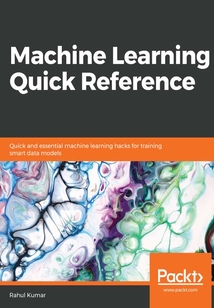舉報 

會員
Machine Learning Quick Reference
Machinelearningmakesitpossibletolearnabouttheunknownsandgainhiddeninsightsintoyourdatasetsbymasteringmanytoolsandtechniques.Thisbookguidesyoutodojustthatinaverycompactmanner.Aftergivingaquickoverviewofwhatmachinelearningisallabout,MachineLearningQuickReferencejumpsrightintoitscorealgorithmsanddemonstrateshowtheycanbeappliedtoreal-worldscenarios.Frommodelevaluationtooptimizingtheirperformance,thisbookwillintroduceyoutothebestpracticesinmachinelearning.Furthermore,youwillalsolookatthemoreadvancedaspectssuchastrainingneuralnetworksandworkwithdifferentkindsofdata,suchastext,time-series,andsequentialdata.Advancedmethodsandtechniquessuchascausalinference,deepGaussianprocesses,andmorearealsocovered.Bytheendofthisbook,youwillbeabletotrainfast,accuratemachinelearningmodelsatyourfingertips,whichyoucaneasilyuseasapointofreference.
目錄(192章)
倒序
- coverpage
- Title Page
- Copyright and Credits
- Machine Learning Quick Reference
- About Packt
- Why subscribe?
- Packt.com
- Contributors
- About the author
- About the reviewers
- Packt is searching for authors like you
- Preface
- Who this book is for
- What this book covers
- To get the most out of this book
- Download the example code files
- Download the color images
- Conventions used
- Get in touch
- Reviews
- Quantifying Learning Algorithms
- Statistical models
- Learning curve
- Machine learning
- Wright's model
- Curve fitting
- Residual
- Statistical modeling – the two cultures of Leo Breiman
- Training data development data – test data
- Size of the training development and test set
- Bias-variance trade off
- Regularization
- Ridge regression (L2)
- Least absolute shrinkage and selection operator
- Cross-validation and model selection
- K-fold cross-validation
- Model selection using cross-validation
- 0.632 rule in bootstrapping
- Model evaluation
- Confusion matrix
- Receiver operating characteristic curve
- Area under ROC
- H-measure
- Dimensionality reduction
- Summary
- Evaluating Kernel Learning
- Introduction to vectors
- Magnitude of the vector
- Dot product
- Linear separability
- Hyperplanes
- SVM
- Support vector
- Kernel trick
- Kernel
- Back to Kernel trick
- Kernel types
- Linear kernel
- Polynomial kernel
- Gaussian kernel
- SVM example and parameter optimization through grid search
- Summary
- Performance in Ensemble Learning
- What is ensemble learning?
- Ensemble methods
- Bootstrapping
- Bagging
- Decision tree
- Tree splitting
- Parameters of tree splitting
- Random forest algorithm
- Case study
- Boosting
- Gradient boosting
- Parameters of gradient boosting
- Summary
- Training Neural Networks
- Neural networks
- How a neural network works
- Model initialization
- Loss function
- Optimization
- Computation in neural networks
- Calculation of activation for H1
- Backward propagation
- Activation function
- Types of activation functions
- Network initialization
- Backpropagation
- Overfitting
- Prevention of overfitting in NNs
- Vanishing gradient
- Overcoming vanishing gradient
- Recurrent neural networks
- Limitations of RNNs
- Use case
- Summary
- Time Series Analysis
- Introduction to time series analysis
- White noise
- Detection of white noise in a series
- Random walk
- Autoregression
- Autocorrelation
- Stationarity
- Detection of stationarity
- AR model
- Moving average model
- Autoregressive integrated moving average
- Optimization of parameters
- AR model
- ARIMA model
- Anomaly detection
- Summary
- Natural Language Processing
- Text corpus
- Sentences
- Words
- Bags of words
- TF-IDF
- Executing the count vectorizer
- Executing TF-IDF in Python
- Sentiment analysis
- Sentiment classification
- TF-IDF feature extraction
- Count vectorizer bag of words feature extraction
- Model building count vectorization
- Topic modeling
- LDA architecture
- Evaluating the model
- Visualizing the LDA
- The Naive Bayes technique in text classification
- The Bayes theorem
- How the Naive Bayes classifier works
- Summary
- Temporal and Sequential Pattern Discovery
- Association rules
- Apriori algorithm
- Finding association rules
- Frequent pattern growth
- Frequent pattern tree growth
- Validation
- Importing the library
- Summary
- Probabilistic Graphical Models
- Key concepts
- Bayes rule
- Bayes network
- Probabilities of nodes
- CPT
- Example of the training and test set
- Summary
- Selected Topics in Deep Learning
- Deep neural networks
- Why do we need a deep learning model?
- Deep neural network notation
- Forward propagation in a deep network
- Parameters W and b
- Forward and backward propagation
- Error computation
- Backward propagation
- Forward propagation equation
- Backward propagation equation
- Parameters and hyperparameters
- Bias initialization
- Hyperparameters
- Use case – digit recognizer
- Generative adversarial networks
- Hinton's Capsule network
- The Capsule Network and convolutional neural networks
- Summary
- Causal Inference
- Granger causality
- F-test
- Limitations
- Use case
- Graphical causal models
- Summary
- Advanced Methods
- Introduction
- Kernel PCA
- Independent component analysis
- Preprocessing for ICA
- Approach
- Compressed sensing
- Our goal
- Self-organizing maps
- SOM
- Bayesian multiple imputation
- Summary
- Other Books You May Enjoy
- Leave a review - let other readers know what you think 更新時間:2021-08-20 10:05:42
推薦閱讀
- Mastering Spark for Data Science
- 傳感器技術(shù)實驗教程
- 數(shù)據(jù)產(chǎn)品經(jīng)理:解決方案與案例分析
- 城市道路交通主動控制技術(shù)
- 精通特征工程
- OpenStack Cloud Computing Cookbook
- Salesforce for Beginners
- Bayesian Analysis with Python
- 工業(yè)機器人入門實用教程
- PowerPoint 2010幻燈片制作高手速成
- MySQL Management and Administration with Navicat
- Cisco UCS Cookbook
- 人工智能:重塑個人、商業(yè)與社會
- fastText Quick Start Guide
- Architectural Patterns
- Building Smart Drones with ESP8266 and Arduino
- 中文版Photoshop CS6數(shù)碼照片處理高手速成
- 從零開始學HTML+CSS
- 新手學Photoshop CS6數(shù)碼照片處理
- INSTANT Oracle GoldenGate
- 微機原理與接口技術(shù)(基于32位機)
- 動畫制作
- Machine Learning Quick Reference
- 主數(shù)據(jù)驅(qū)動的數(shù)據(jù)治理:原理、技術(shù)與實踐
- 新編計算機導(dǎo)論(第2版)
- 神經(jīng)網(wǎng)絡(luò)控制
- Excel 2007表格應(yīng)用百練成精
- Mastercam X4中文版完全自學一本通
- AutoCAD 2009典型案例設(shè)計
- Learning Elastic Stack 7.0(Second Edition)

